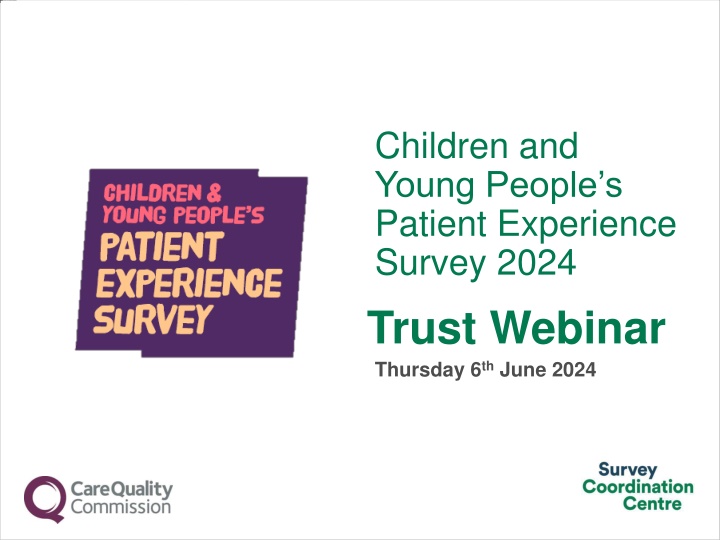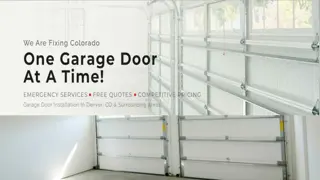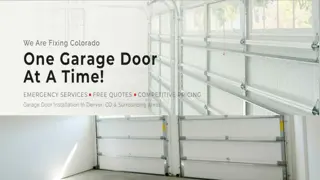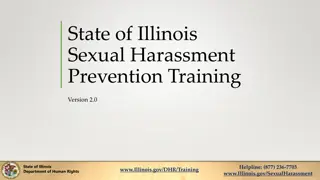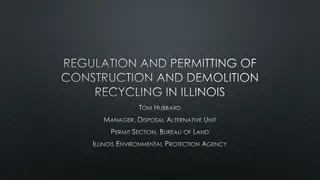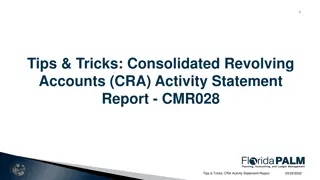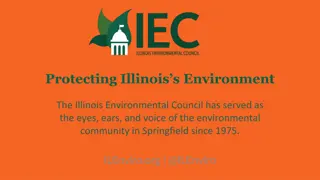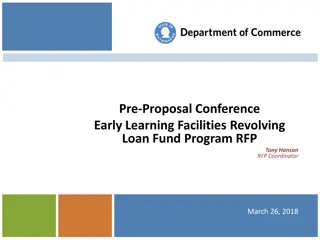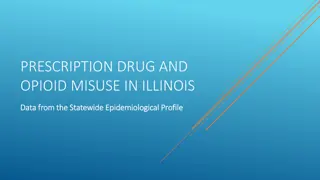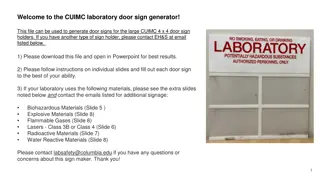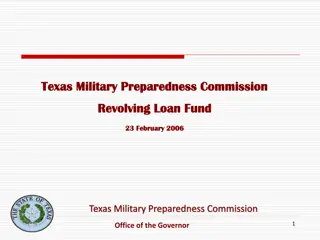Revolving Door Provisions in Illinois
This content outlines the Revolving Door Prohibition affecting state employees in Illinois, including restrictions on accepting employment or compensation from vendors, grantees, or regulated entities after termination. It details different categories of employees subject to these rules and the process for seeking approval from the Office of Executive Inspector General. The provisions aim to prevent conflicts of interest and maintain integrity in state governance.
Download Presentation

Please find below an Image/Link to download the presentation.
The content on the website is provided AS IS for your information and personal use only. It may not be sold, licensed, or shared on other websites without obtaining consent from the author.If you encounter any issues during the download, it is possible that the publisher has removed the file from their server.
You are allowed to download the files provided on this website for personal or commercial use, subject to the condition that they are used lawfully. All files are the property of their respective owners.
The content on the website is provided AS IS for your information and personal use only. It may not be sold, licensed, or shared on other websites without obtaining consent from the author.
E N D
Presentation Transcript
Children and Young People s Patient Experience Survey 2024 Trust Webinar Thursday 6th June 2024
Agenda Overview of 2024 survey [5 mins] Sampling approach [5 mins] Contact approach [10 mins] Questionnaire development [5 mins] Data Protection and Section 251 Requirements [5 mins] Potential Sampling Errors [5 mins] Instruction Manuals [5 mins] Entering fieldwork [5 mins] Key dates [5 mins] Questions [10 mins] 2
Overview of the 2024 survey 3
What is the CYP Survey? One of the five experience surveys of the NHS Patient Survey Programme (NPSP.) Conducted every 2 years; results are crucial to improving the quality of care and experience of children and young people. The Care Quality Commission (CQC) uses the results to assess NHS performance and for regulatory activities. Results are also used by a range of stakeholders: Individual NHS trusts and commissioners NHS England Department of Health and Social Care o o o The most recent CYP Survey was conducted in 2020 and it is being conducted again in 2024. 4
Survey Design The 2024 Children and Young People s Patient Experience Survey uses three different questionnaires, each one appropriate for a different age group of patients sampled: 0-7 questionnaire: sent to the parents of patients aged between 15 days and 7 years old at the time of discharge. o 8-11 questionnaire: sent to patients aged between 8 and 11 years old at the time of discharge. o 12-15 questionnaire: sent to patients aged between 12 and 15 years old at the time of discharge. o The 0-7 questionnaire is completed entirely by the sample patient s parent/carer. 8-11 and 12-15 questionnaires have a short section for the child or young person to complete, followed by a separate section for their parent/carer to complete. 5
Data collection approach Mixed mode data collection method: Online survey, paper questionnaire Push to web approach Inclusion of QR codes on cover letters Online survey (mobile first, responsive design) Centralised survey offered Translations provided Multi-language sheet, inclusion of QR codes for translated surveys Paper questionnaire: 8 pages Surveys redesigned for 2024 but follow the same layout (dual columns) as other NPSP surveys. Braille, large print and Easy Read provided o o o o o o o o o o 6
Sampling method: size, period & approach Eligible population: o Admitted patients (inpatients and day cases by either elective or emergency route of admission) aged between 15 days and 15 years (inclusive), discharged between 1st March and 31st May 2024 (inclusive). o Excluding; new-born babies where the mother was primary patient, o neonatal patients, o obstetrics, o patients admitted for planned termination of pregnancy o psychiatry patients (including CAMHS). o 8
Sampling: variables (new) NHS Number: This is to enable contractors to run centralised DBS checks for all their clients. o Contractors will be able to run DBS checks in advance of contact attempts without Trust involvement. Do not share NHS numbers with the Survey Coordination Centre. o Mobile phone indicator and number The sample will contain a binary indicator to show where a mobile phone is available. o The mobile phone number will be used to send reminder SMS messages as outlined in the contact strategy. o 9
Sampling: variables (new) Full date of birth: This is to enable contractors to run centralised DBS checks for all their clients. o The Survey Coordination Centre should receive only the month and year of birth. o Sub-Integrated Care Board (ICB) codes: These have replaced CCG codes. o CCGs have been subsumed by Integrated Care Boards (ICBs), and accordingly in place of CCG codes, we are asking Trusts to provide sub- ICB location codes for hospital patients. o 10
Sampling: variables (removed) 2 Covid infection status variables: Two sample variables, related to COVID 19 infection status, have been removed. o These variables were more relevant in the previous iteration of the survey, as this took place in 2020 during the pandemic. o There variables are COVID-19 diagnosis and Treated as a suspected or confirmed COVID-19 case (derived from Trust locally held records). o CCG codes: As these are being replaced by sub-ICB location codes, they will no longer be relevant. o 11
Contact approach DBS and local checks required before each mailing. Contact approach discussed with participants during cognitive testing. Two contact strategies depending on availability of mobile phone numbers. Group A: For trusts <50% mobile numbers Group B: For trusts >=50% mobile numbers Days from first mailing Mailing 0 M1 Letter with URL Letter with URL (Week 1) +5 days (Week 1) 10 days SMS1 SMS after M1 SMS after M1 Letter with URL and paper questionnaire M2 Letter with URL (Week 2) SMS2 +15 days (Week 3) 21 days SMS after M2 SMS after M2 Letter with URL and paper questionnaire Letter with URL and paper questionnaire M3 (Week 4)
DBS Checks Due to the increased sensitivity of the sample data, both DBS and local checks should be conducted before any contact (mailing or SMS) is sent. o Some contractors have the capability of running DBS checks during fieldwork on the trusts behalf. o This removes the requirement for trusts to run DBS and local checks ahead of mailing two and mailing three. o Trusts are still expected to run the initial DBS checks when drawing the initial sample. o NHS Number and full date of birth will be required in the sample sent to your contractor to allow them to conduct DBS checks on your behalf during fieldwork. o Please discuss further with your contractor. 14
Safeguarding When addressing any safeguarding concerns, as a guiding principle please use your Trust s own safeguarding guidelines. If further assistance is required, please contact the SCC with any queries, and we will assist on a case-by-case basis. Trusts will be asked to keep a record of how many cases were excluded for safeguarding, and provide a brief overview of the specific concerns on the sample declaration form. 15
Use of mobile numbers Mailing data will contain mobile phone numbers to send SMS texts to patients. o Most of these numbers will belong to parents, but some will belong to children/ young people where they have taken ownership of their care. o It is important to be mindful of the sensitive nature of phone numbers belonging to children/ young people. o If you have any concerns about sharing a mobile number associated with a patient, please use your Trust s own safeguarding guidelines and reasonable judgement as to whether it should be shared in this instance. o CQC will provide further guidance on handling queries about mobile phone numbers. This will include a centralised public facing guidance document. o 16
Use of mobile numbers CQC carried out research exploring the ethical and safeguarding concerns of using mobile numbers for this purpose. We have taken several actions in line with the findings of this research to address concerns about children receiving SMS messages from unknown numbers. Giving forewarning of the automated SMS messages in the covering letters. o Including the mobile number used in the contact in the cover letters. o This may generate additional calls for contractors and Trusts running the survey themselves, asking to update or not contact this number. Where possible, this should be actioned, but due to the proximity of the mail out and SMS reminders, we appreciate this may not always be possible. SMS messages will arrive after school hours to help ensure parent and child can complete the survey together. o 17
Cover letters Cover letters were redesigned to include a QR code The 2024 mailing letters will include a QR code. Once scanned they will be taken directly to the online survey. o This will mitigate the need for patients to type in the web address. Patients will also be automatically logged in without needing to enter their unique password. o Inclusion of the contact number to which SMS reminders will be sent The contact letters give forewarning that text reminders will be sent to participants and provide the last 4 digits of the number that will be contacted. o This is done as the mailing contacts are addressed to the parent, but there is a possibility that SMS could go to the child or to an incorrect number. o 18
Information leaflet Sent out with the first mailing o Question and answer format o 2 pages, colour print o Tested with young people to ensure it has the information they want o Sent to the 8-11 and 12-15 s o
Communication toolkit A set of social media cards to be used throughout fieldwork o Press release template o Website banner for use on social media o
Development process The 2024 survey is a complete re-development of the CYP survey. The 2020 questionnaire acted as a foundation to develop the new survey, but despite some similarities the results will not be comparable. Pilot to change survey method (mixed mode) o Evaluation of relevant developments in acute children's health care policy o 2020 Questionnaire Performance Analysis o CYP Workshops o Stakeholder Interviews o Consultative Trust Webinar o Cognitive testing o 22
Children's section Section Examples - If you used the hospital Wi-Fi, was it good enough to do what you wanted? -How suitable was the ward for someone your age? -Was there enough choice of hospital food? Staying In Hospital Looking After You In Hospital -Were you involved in decisions about your care and treatment as much as you wanted to be? - How friendly were the staff looking after you? Talking To Hospital Staff -How well did staff explain your care and treatment to you? -Did staff take the time to listen to your fears or worries? The Waiting Area -Did you have to wait in a hospital waiting area? -Did any of the following bother you when you were in the waiting area? -In hospital, did you have any operations or procedures? -Before the operations or procedures, how well did staff explain what would be done? -When you left hospital, did you know what was going to happen next with your care and treatment? -Overall, how well were you looked after in hospital? Free text box for their own opinions Operations & Procedures Leaving Hospital And Finally Anything Else To Say? 23
Parents section Section Examples The Waiting Area -If your child had to wait in a hospital waiting area, where was this? -When you were waiting, was your child able to get help from staff if they needed it? -How clean was the hospital room or ward? -Did the ward have appropriate equipment or adaptations for your child s physical or medical needs? -Did staff give you information about your child s care and treatment in a way that you could understand? -Did you feel staff caring for and treating your child knew how to care for their needs? -If you raised any concerns about your child's care and treatment, were these taken seriously by staff? -Was there enough choice of hospital food for your child? The Hospital Ward Talking To Staff Looking After Your Child Hospital Food Facilities Pain -Overall, how would you rate your access to food in hospital? -If your child felt pain while at hospital, did staff do everything they could to help them? -In hospital, did your child have any operations or procedures? -Afterwards, how well did staff explain how the operations or procedures had gone? -When you left hospital, did you know what was going to happen next with your child s care and treatment? -Overall, do you feel you (the parent / carer) were well looked after by the staff? Operations And Procedures Leaving Hospital Overall Anything Else To Say? Free text box for their own opinions 24
Data protection and Section 251 requirements 25
General Data Protection Regulation (GDPR) How patient s personal data is being protected under the GDPR is stated on the reverse side of the covering letter for each mailing: 26
Section 251 requirements: dissent posters Dissent posters give potential participants the opportunity to opt out of the survey, available on the NHS Surveys website. o Posters should have been displayed during the sampling months (March, April and May 2024) to comply with Section 251 requirements. o We ask you publicise the survey both internally and externally to ensure patients are aware of the survey and have the opportunity to opt-out should they wish. Example materials are available in the 'Publicising survey document. o You can also use the publicity materials we will provide you with. o Ensure a log of patients who have dissented from taking part in the survey is accurately kept. o Section 251 allows patient data to be shared outside of NHS trusts without gaining prior and explicit consent from these patients. o 27
National Data Opt-Out Programme NPSP received exemption from National Data Opt-out Programme. o Continued separate opt-out mechanisms. o Patients do not have to actively consent to the sharing of their data for the CYP24 survey. o
Potential Errors - How to avoid them Examples of checks you should do before submitting your sample: Check distribution of patient ages in your sample Check distribution of patient gender Check distribution of patient admission method Are there any errors in the query used to extract the eligible population? Are there any missing/incomplete data in your initial database? Be aware of system migrations. Ensure patients on the national opt out register are not excluded Check all codes provided in your sample are valid Check admission and discharge dates are as expected Check admission and discharge sites are correct 30
Sample Declaration Form Completing the Sample Declaration Form can help avoid errors. Avoiding errors will ensure your questionnaires can be mailed out earlier and your data will be usable in this year s survey. Includes: Checklist Declaration Agreement o To be signed by person drawing sample and Caldicott Guardian Tip: Take care to fill in dates Tip: Schedule time for sign-off in advance with Caldicott Guardian o Submission Sample declaration form to be submitted to your contractor (or SCC if an inhouse trust) Once the sample declaration form has been approved please submit your sample safely via secure file transfer site. 31
Instruction Manuals - Survey Handbook For survey leads Brief document o Survey specific o Key summary document that links to all other relevant information: o What s new for the CYP24 survey Tips on managing the survey Tips on implementing the survey Key dates: Top level Highlights on key information (Section 251, etc.)
Instruction Manuals - Sampling Instructions For sample drawers (data team) o Detailed information on how to draw a sample step by step Overview of CYP24: o Additional sample variables o Survey specific o Step-by-step instructions on how to draw sample o Flowchart o Links to relevant information
Instruction Manuals - Other Sample construction spreadsheet Sample, mailing and fieldwork variables o Sample declaration form Checklist Declaration agreement Sub-ICB list o o o
Generic NPSP Instruction Documents Patient feedback and the NHS Constitution 1) Setting up a project team 2) Data protection and confidentiality 3) Ethical issues, ethical committees and research 4) governance Separate PDF documents on NHS Surveys website Collecting data from non-English speaking populations 5) Publicising the survey 6) Implementing the survey practicalities 7) Submitting samples 8) Entering and submitting final data 9) Making sense of the data 10) Reporting results 11) Universal glossary 12)
Entering fieldwork early / on time Entering fieldwork on time or earlier will help your trust to maximise responses from younger and minority ethnic groups. You will also likely receive an overall higher response rate, providing your trust with more data. Ensure you have a survey team in place before you start drawing your sample. Generate your sample promptly - begin preparing now. Respond to queries as soon as possible to avoid unnecessary delays. Ensure there is sufficient resourcing around the time of drawing your sample and answering queries communicate with your team, handover tasks if people are going to be on leave and let your contractor and the SCC know any updates. If there are any changes in the survey lead, inform your contractor and the Survey Coordination Centre (SCC). 38
Key Dates 39
Key dates overview Task Date Dissent posters available on the website 5th March 2024 Ensure project team (Caldicott Guardian and person drawing sample) are aware of project timings June 2024 Provide Survey Coordination Centre with contact details of project team June 2024 Trust Webinar 6th June 2024 Send completed statement of compliance to Survey Coordination Centre Display dissent posters within trust Final materials available on the website June 2024 March-May 2024 w/c 3rd June 2024 Send PDF copies of the questionnaire, cover letter and SMS text to Survey Coordination Centre 14th June 2024 Send hard copies of the questionnaire, cover letter and SMS to Survey Coordination Centre 28th June 2024 40
Key dates overview Task Date Sample to be drawn and checked Completed sample declaration form to be signed by Caldicott Guardian Submit sample declaration form to Survey Coordination Centre Submit sample data to the Survey Coordination Centre OR approved contractor Fieldwork starts Submit interim data file to the Survey Coordination Centre Fieldwork ends Send final data to Survey Coordination Centre 10th June 2024 8th July 2024 By 1st July 2024 By 1st July 2024 By 8th July 2024 15th July 2024* 2nd September 2024 25th October 2024 1st November 2024 41
Questions? 42
Thank you for your time Copy of the slides will be on the NHS Surveys website Contact us: cyp@surveycoordination.com 01865 208127 43
